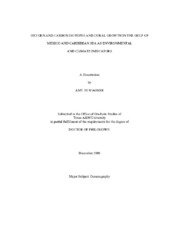| dc.contributor.advisor | Slowey, Niall | |
| dc.creator | Wagner, Amy Jo | |
| dc.date.accessioned | 2011-02-22T22:23:32Z | |
| dc.date.accessioned | 2011-02-22T23:44:13Z | |
| dc.date.available | 2011-02-22T22:23:32Z | |
| dc.date.available | 2011-02-22T23:44:13Z | |
| dc.date.created | 2009-12 | |
| dc.date.issued | 2011-02-22 | |
| dc.date.submitted | December 2009 | |
| dc.identifier.uri | https://hdl.handle.net/1969.1/ETD-TAMU-2009-12-7260 | |
| dc.description.abstract | The Gulf of Mexico and Caribbean Sea comprise a sensitive and important
region, both oceanographically and climatically. A better understanding of the history of
climate and marine environmental conditions in this region provides valuable insight
into the processes that affect climate globally. This dissertation furthers our
understanding of these factors via investigations of the isotopes of corals and seawater,
as well as coral growth. Results improve our understanding of how the isotope and coral
growth records from the Gulf of Mexico and Caribbean Sea reflect recent environmental
conditions, enhancing our ability to reconstruct the history of climate in this important
region.
Analysis of the relationship between salinity and oxygen isotopic composition of
seawater from the Texas/Louisiana continental shelf and Flower Garden Banks yield
improved understanding of the relative contribution of the fresh water sources into the
northern Gulf of Mexico, and also the oxygen isotopic composition of open-ocean
seawater in this region.
Variations in the growth of long-lived coral cores from the Flower Garden Banks
are compared to local and regional climate conditions, particularly winter air
temperatures. During the latter half of the twentieth century, a close correlation has
existed between slow coral growth and cold wintertime air temperatures along the Gulf
Coast, which are due to a meridional orientation of the North American jet stream (associated with the Pacific/North American climate pattern). Existing long coral
growth records are too limited to assess this relationship during earlier years.
Knowledge of the marine radiocarbon (14C) reservoir age is important for
understanding carbon cycling and calibrating the radiocarbon ages of marine samples.
Radiocarbon concentrations in corals from the Flower Garden Banks, Veracruz, and the
Cariaco Basin are measured and used to determine the surface ocean 14C reservoir ages
for the Gulf of Mexico and Caribbean Sea. Results also indicate that the post-nuclear
weapons testing Delta 14-C values of the Gulf of Mexico and Caribbean Sea differ. This
difference is attributed to the advection of 14C-depleted surface water from the Southern
Hemisphere into the Caribbean Sea.
The results reported in this dissertation provide valuable information for
understanding the marine environment when using carbonate proxies to study and
reconstruct past climate and marine conditions in the Gulf of Mexico and Caribbean. | en |
| dc.format.mimetype | application/pdf | |
| dc.language.iso | en_US | |
| dc.subject | climate | en |
| dc.subject | corals | en |
| dc.subject | isotopes | en |
| dc.subject | radiocarbon | en |
| dc.title | Oxygen and Carbon Isotopes and Coral Growth in the Gulf of Mexico and Caribbean Sea as Environmental and Climate Indicators | en |
| dc.type | Book | en |
| dc.type | Thesis | en |
| thesis.degree.department | Oceanography | en |
| thesis.degree.discipline | Oceanography | en |
| thesis.degree.grantor | Texas A&M University | en |
| thesis.degree.name | Doctor of Philosophy | en |
| thesis.degree.level | Doctoral | en |
| dc.contributor.committeeMember | Giese, Benjamin | |
| dc.contributor.committeeMember | Thomas, Deborah | |
| dc.contributor.committeeMember | Grossman, Ethan | |
| dc.contributor.committeeMember | Guilderson, Thomas | |
| dc.type.genre | Electronic Dissertation | en |
| dc.type.material | text | en |


